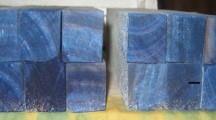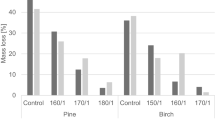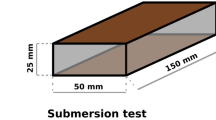Abstract
The rates of stabilization or fixation of copper in ACQ-treated wood were compared for different post treatment conditioning temperatures (22°C and 50°C), solution concentrations (0.4–2.3%) and wood species. In some species, sapwood/heartwood differences were evaluated. The rate and extent of copper stabilization were estimated from changes in concentration of expressed solution at different times after treatment. The quality of the stabilization reaction was evaluated based on leaching performance of the wood after conditioning. Copper stabilized much faster at lower ACQ retentions and when conditioned at 50°C compared to high retentions and stabilization at 22°C. High retention treatments held without drying at 22°C could require five weeks or more for the copper to stabilize in the wood. Generally species effects were minor for the species evaluated, except for Douglas-fir in which copper reacted more quickly than in other species.
Zusammenfassung
Der Grad der Stabilisierung oder Fixierung von Kupfer in ACQ-behandeltem Holz wurde verglichen für Wärme-Nachbehandlungen bei 22°C und 50°C für Tränkkonzentrationen zwischen 0,4% und 2,3% und für verschiedene Holzarten. Rate und Ausmaß der Kupferstabilisierung wurden abgeschätzt aus der Konzentrationsänderung der zu verschiedenen Zeiten ausgepressten Tränklösung nach der Behandlung. Die Güte der Stabilisierungsreaktion wurde abgeschätzt anhand des Auslaugverhaltens nach der Konditionierung. Kupfer stabilisierte sich viel schneller bei geringeren ACQ-Konzentrationen und Konditionieren bei 50°C im Vergleich zu hohen Rückhaltekonzentrationen und Wärmebehandlung bei 22°C. Bei hohen Rückhaltekonzentrationen ohne Trocknung bei 22°C kann es bis zu fünf Wochen oder noch länger dauern, bis das Kupfer sich im Holz stabilisiert. Allgemein war der Einfluss der untersuchten Holzarten gering außer bei Douglasie; hier reagierte das Kupfer viel schneller als in anderen Holzarten.








Similar content being viewed by others
References
AWPA (1999) Book of standards. American Wood Preservers’ Association, Woodstock, MD 21163-0286, USA
Cooper PA (1998) Diffusion of copper wood preservatives in wood cell walls following treatment. Wood Fiber Sci 30(4):382–395
Jiang X, Ruddick JNR (1999) A spectroscopic investigation of copper ethylenediamine fixation in wood. International Research Group on Wood Preservation Document No IRG/WP 99-20160
Jiang X, Ruddick JNR (2000) A comparison of the leaching resistance of copper 2-ethanolamine and copper ethylenediamine treated scots pine. International Research Group on Wood Preservation Document No IRG/WP 00-30233
Kamdem DP, Zhang J (2000) Contribution of wood components on the absorption of copper amine. International Research Group on Wood Preservation Document No IRG/WP 00-30216
Lucas N, Ruddick JNR (2002) Determination of the amine to copper ratio remaining in wood after water leaching. International Research Group on Wood Preservation Document No IRG/WP 02-30285
Pasek EA (2003) Minimizing preservative losses: fixation a report of the P4 migration/fixation/depletion task force. In: Proceedings, American Wood Preserver’s Association 2003:100–124
Ruddick JNR (1996) The fixation of ammoniacal copper preservatives. Branch Lines. UBC Fac Forestry Newslett 7(2):2
Ruddick JNR (2003) Basic copper wood preservatives, preservative depletion: factors which influence loss. Proc Can Wood Preserv Assoc 24:26–59
Stevanovic-Janezic T, Cooper P, Ung T (2001) Chromated copper arsenate preservative treatment of North American hardwoods. Part 2: leaching performance. Holzforschung 55:7–12
Zhang J, Kamdem DP (2000a) FTIR characterization of copper ethanolamine—wood interaction for wood preservation. Holzforschung 54:119–122
Zhang J, Kamdem DP (2000b) Interaction of copper amine with southern pine: retention and migration. Wood Fiber Sci 32(3):332–339
Author information
Authors and Affiliations
Corresponding author
Rights and permissions
About this article
Cite this article
Ung, Y.T., Cooper, P.A. Copper stabilization in ACQ-D treated wood: retention, temperature and species effects. Holz Roh Werkst 63, 186–191 (2005). https://doi.org/10.1007/s00107-004-0555-1
Published:
Issue Date:
DOI: https://doi.org/10.1007/s00107-004-0555-1




